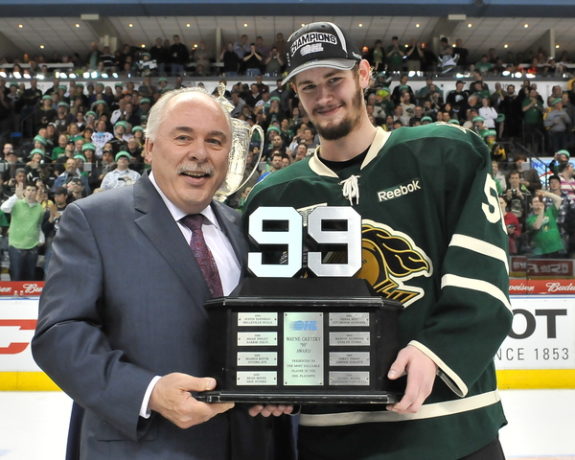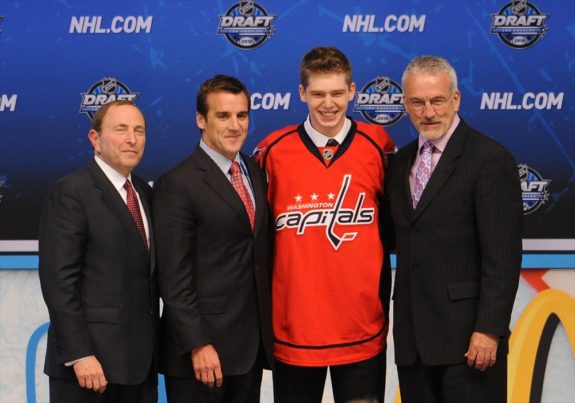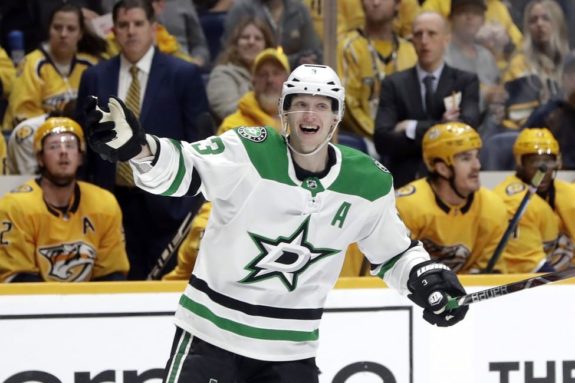The David Poile Draft feature began with Kyle Gipe and his coverage of the 1998-2009 drafts. The feature went on pause, but I’m going to be reviving it to catch up on most of the 2010 decade of Nashville Predators drafting. For those that missed it, here are the links to the initial set:
- 1998: Franchise’s Inaugural Draft
- 1999: Erat Leads to Forsberg
- 2000: Scott Hartnell and Nothing Else
- 2001: Hamhuis and Tootoo
- 2002: What was Poile Thinking?
- 2003: The Suter and Weber Draft
- 2004: Predators Get Franchise Goaltender
- 2005: Drafting Hornqvist Last Overall
- 2006: Worst Draft in Franchise History?
- 2007: Nick Spaling Leads to James Neal…Eventually
- 2008: Predators Land Future Captain in Josi
- 2009: Success Everywhere but Round Two
The 2010 Draft was dubbed as the ‘Taylor vs. Tyler’ draft, but aside from those two surefire prospects, the rest of the first round was fraught with land mines. There were 19 regular NHLers to come out of the first round of the draft, but a lack of all-star talent and some players who quickly fell off the map make this a draft that hurts to look back on for many teams, the Predators among them.

The Predators weren’t going to have to bother with any of the surefire talents dropping to them at the 18th selection, so to be able to get one of the regular NHLers is not a bad start. Unfortunately for the Predators, that was all that the 2010 Draft had to offer, with half of the selections never even suiting up in the NHL.
Early Rounds (1-2)
Round 1, 18th Overall – Austin Watson, RW (London Knights, OHL)
Austin Watson was born in Michigan, but his route to the NHL went through Windsor, Peterborough, and London of the OHL. The power forward scored 17 points in 19 playoff games in his draft year on route to being the OHL playoff MVP.
It took Watson until 2013 to break into the Predators’ lineup, and even then, he only got a brief six games of action. Finally, in the fall of 2015, the young winger finally made an impact with the big club, scoring 10 points and earning 32 penalty minutes (PIMs) across 57 games. He peaked at 19 points and 123 PIMs in 2018 but never amounted to more than a role player. He signed a three-year extension at $1.5 million per year in the fall of 2019, though he wasn’t set to become a free agent until the end of the season. Watson was then traded to the Ottawa Senators in the 2020 offseason for a fourth-round pick, though that new contract isn’t looked at favourably there either.
The Predators traded their second-round pick (48th overall) in return for four games of Dennis Grebeshkov. They then used the pick on LW Curtis Hamilton, so the Predators didn’t actually miss much. Calle Jarnkrok was selected three picks later, and he would become a Predator in 2014 as part of the David Legwand trade.
Missed Opportunity: Washington Capitals select Evgeni Kuznetsov, C (Traktor Chelyabinsk, KHL) – 26th Overall

Kuznetsov would have fit the Predators’ need for a top-line centre, and he’s followed a similar career arc to that of current Predator Ryan Johansen, but with a higher scoring peak. Without the dire need to trade for a top-line offensive centreman, does Nashville still own Seth Jones? Do they find another top-tier forward for Jones in a trade? However, if the Capitals don’t have Kuznetsov in their system, maybe they aren’t comfortable dealing Filip Forsberg. It’s fun to think what could have been had Nashville drafted the Russian centre instead of the OHL power forward.
Middle Rounds (3-5)
Round 3, 78th Overall – Taylor Aronson, D (Portland Winterhawks, WHL)
Taylor Aronson was the first skater that the Predators drafted out of the WHL in three years, and they signed him to his entry-level contract (ELC) six months later. The 6-foot-1, right-shot defenceman from California was a bit of a raw prospect, but one with all-around upside and excellent puck skills. He progressed well after the draft and adjusted well to the AHL, where he earned himself another contract when his ELC expired in 2015.
Unfortunately, it was all downhill from there, as Aronson was upset by being left in the minors for the entirety of the 2016 season and ultimately deserted the AHL club right before playoffs. He never played a game for the Predators and has since played in the KHL and the DEL.
Round 5, 126th Overall – Patrick Cehlin, RW (Djurgårdens IF, SEL)
Patrick Cehlin was another bust (due to no fault of his own) who ended up starring with the Milwaukee Admirals for a short period of time before crossing overseas to continue his career. The 5-foot-11 right winger stood out as one of the best forwards on the Predators’ AHL affiliate over his season and a half there. However, two long-term injuries derailed his progression and were the main cause of him seeing time in the ECHL, which prompted a loan to Europe from which he never returned. He has not played in any tracked league since 2018.
Missed Opportunity: Dallas Stars select John Klingberg, D (Frolunda HC, J20 SuperElit) – 131st Overall

From the same league that the Predators stole Mattias Ekholm in the fourth round the year prior, there was another skilled defenceman sitting there in the fifth round. Klingberg’s production rocketed up in the J20 league right after being drafted, and he bounced around the higher levels for a few years after that. The smooth-skating, right-shot defenceman finally made his North American debut with the Texas Stars in the 2013 Playoffs. He played an injury-shortened 2014-15 season in Texas before breaking into the NHL full time in the fall of 2015.
Late Rounds (6-7)
Round 6, 168th Overall – Anthony Bitetto, D (Portland Winterhawks, WHL)
The lone bright spot from the Preds’ draft after round one, and it’s closer to the shine of that flashlight that you haven’t pulled out of the drawer for a couple of years. Bitetto made the NHL in 2014 with the Predators, playing seven games. He kept his role as the seventh defenceman with the club up until the 2018-19 season when they traded him to the Minnesota Wild. The left-shot defenceman has made a career as a journeyman depth player who can fill in when injuries hit. He peaked last season at 51 games with the Winnipeg Jets and is currently under contract with the New York Rangers.

There was a missed opportunity here with a WHL skater by the name of Mark Stone who went 178th overall — you may have heard of him. We’ll give the Predators a pass, though, as Stone was passed over by every team at least four times in the draft. As a draft-eligible player, he only put up 28 points in 39 games, but he exploded for 106 points in 71 games the next season and has been a star producer ever since.
Round 7, 194th Overall – David Elsner, RW (Landshut Cannibals, 2nd Bundesliga)
After being drafted in 2010, David Elsner played one more season in Germany, still with the Landshut Cannibals, posting five points in 31 games (half of the production rate from his draft year). In the summer of 2011, he crossed over to try his hand with the North American game in the OHL. He put up 14 points in 48 games with the Sault Ste. Marie Greyhounds before returning to Germany for the rest of his career.
Round 7, 198th Overall – Joonas Rask, C (Ilves, SM-liiga)
Joonas Rask is the younger brother of Boston Bruins’ goalie Tuukka Rask, but unfortunately for the Predators, he didn’t follow in his brother’s successful NHL footsteps. The 5-foot-11 centre from Finland played two games for the Predators in the 2012-13 season, notching a single assist, plus one game in the AHL where he scored two points. After that successful North American debut, Rask played the full 2013-14 season in the AHL and racked up 14 points over a full 58-game season. As a restricted free agent that summer, Rask decided he wanted to move back to Finland and has been playing in Europe ever since.
Overall Grade: D
The only thing holding this draft above a failing mark is selecting Auston Watson and his 300 game career with the Predators and not completely bombing the selection with other late 2010 first-rounders such as Beau Bennett or Emerson Etem. Getting a combined 116 games and 20 points out of the other five selections is not something to be bragging about. There wasn’t a lot of overall depth in the 2010 Draft, and aside from the aforementioned Klingberg & Stone, plus goaltender Frederik Andersen (who re-entered the draft in 2012), there weren’t even a lot of mid-late round gems to be found. Overall, a poor showing in a weaker NHL draft class.